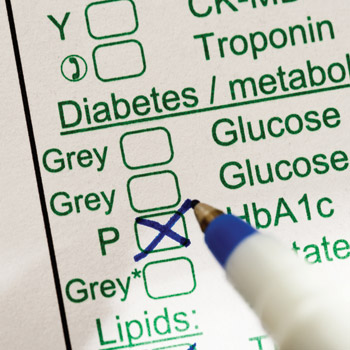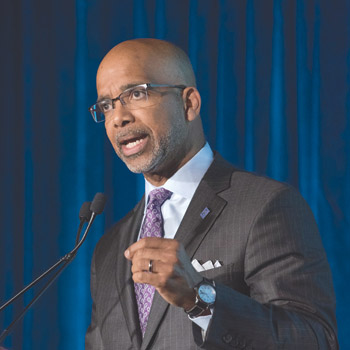Managing patients with diabetes and heart failure
Good control of diabetes in the presence of heart failure includes appropriate HbA1c targets, metformin and comprehensive lifestyle change as first-line therapy, and a team approach.
Diabetes and heart failure often go hand in hand, and treating one can greatly affect the other. Christina Mitchell, MD, gave the endocrinologist's perspective on treating patients with both conditions at the Heart Failure Society of America's 2019 annual meeting, held in Philadelphia in September.
Research indicates that risk for heart failure in patients with diabetes increases with HbA1c level, Dr. Mitchell said. For example, the United Kingdom Prospective Diabetes Study (UKPDS), which was published in 2000 in BMJ, found a linear increase of 16% in heart failure development with each 1% increase in HbA1c in 4,000 patients with newly diagnosed diabetes. “This certainly makes the treatment of diabetes very important in the setting of heart failure,” said Dr. Mitchell, an associate professor of medicine in the division of endocrinology, diabetes, and metabolism at the University of Pennsylvania's Perelman School of Medicine in Philadelphia.
What goals?
Lower HbA1c targets are not necessarily better, Dr. Mitchell said. Research published in the Journal of the American College of Cardiology in 2009 separated a retrospective cohort of veterans into five quintiles based on their HbA1c management: 6.4% or lower, 6.4% to 7.1%, 7.1% to 7.8%, 7.8% to 9.0%, and greater than 9%. The lowest risk for death was seen in the middle quintile, which suggests that a more modest goal of 7.1% to 7.8% is better than aiming for the lowest HbA1c possible, Dr. Mitchell noted.

“Suffice it to say … that the intensification of glycemic control in a randomized controlled trial has not been associated with a reduction of heart failure events,” she said. She pointed out that the ADVANCE trial, which targeted an HbA1c of 6.5%, found an increase in admissions for heart failure and that the ACCORD trial, which targeted an HbA1c goal of 6.0% “using whatever means necessary in terms of medications,” found an increased risk for death. Both ADVANCE and ACCORD were published by the New England Journal of Medicine in 2008.
“ADVANCE basically was more suggestive that intensive control could be beneficial but ultimately was not significant in that regard,” Dr. Mitchell said. “So the question is, why was there this difference in ACCORD versus ADVANCE in terms of ACCORD showing a greater cardiovascular mortality?”
In ACCORD, 77% of patients in the treatment group were on insulin compared to 55% of the control group, and 92% were on thiazolidinedione therapy compared to 58% of the control group. In ADVANCE, 41% of patients were on insulin in the treatment group versus 24% in the control group, and only 17% of those in the treatment group were on thiazolidinediones versus 11% in the control group. These data, Dr. Mitchell said, suggest that the medications that were used in each study contributed to the differences in outcomes, “which is a nice segue to saying, well, what medication should we be using, then, for the management of diabetes in the setting of heart failure?”
What medications?
“Despite the numerous agents that are available to us, first-line therapy remains metformin and comprehensive lifestyle change, including weight management and physical activity,” Dr. Mitchell said. “So that leads us to talk a little bit more about the role of metformin here and how we should be using that in the setting of diabetes and heart failure.”
Metformin, a biguanide, decreases glucose absorption in the large intestine. “It's weight-neutral, which is very beneficial, and in some folks can induce weight loss, likely due to its effect on reducing insulin resistance,” Dr. Mitchell said. She noted that because it is excreted unchanged, it can accumulate in patients with renal insufficiency, leading to concern about development of lactic acidosis. Metformin is contraindicated in the setting of metabolic acidosis and in hypoxic states such as acute heart failure and renal failure, she said. Because it requires the presence of insulin to work, it's not effective in patients with type 1 diabetes, but it is safe to use in patients with type 2 diabetes in the setting of stable heart failure, she said.
Metformin lowers HbA1c by as much as 2%, “which, as far as the oral medications go, is quite dramatic,” Dr. Mitchell said. “We don't see that degree of A1c lowering with any of our other oral medications.” Patients taking metformin should be counseled about bloating and nausea and diarrhea, which are common associated side effects, she said. She noted that these symptoms can sometimes get better with time and patience and that the extended-release version of the drug can help reduce them.
No randomized controlled trials have demonstrated that metformin reduces the risk of heart failure in patients with type 2 diabetes, Dr. Mitchell said. However, a meta-analysis published in 2017 in Diabetologia found that metformin was associated with reduced risk for myocardial infarction and cardiovascular death, although Dr. Mitchell noted that the UKPDS contributed most of the data used for the summary estimates.
Metformin is safe to use in renal insufficiency, especially if patients were taking it before their glomerular filtration rate (GFR) began to decrease, Dr. Mitchell said. “Within the past several years, we feel very comfortable using it to an [estimated] GFR of 30 [mL/min/1.73 m2], although a dose reduction may be necessary as GFR decreases with time,” she said.
In patients who are unable to take metformin or those who need to add another agent to reach their HbA1c goals, the American Diabetes Association next recommends a sodium-glucose cotransporter-2 (SGLT-2) inhibitor. These drugs “contribute to the excretion of 50 to 100 grams of glucose a day, which is quite significant,” Dr. Mitchell said. However, an association with bladder cancer and lower-limb amputation has been reported for dapagliflozin and canagliflozin, respectively. (She noted that canagliflozin or empagliflozin is more likely to be used than dapagliflozin because of dapagliflozin's association with bladder cancer.)
“This class of meds, in terms of advising patients, not only will they see an improvement in glycemic control but also blood pressure control and some modest weight loss of about 2.2%,” Dr. Mitchell said. SGLT-2 inhibitors are associated with an increased risk for vaginal candidiasis, urinary tract infections, and polyuria, as well as a small risk for euglycemic diabetic ketoacidosis.
“One other thing I will say about the SGLT-2s, however, is that they do come in combination with metformin, so when you're using this as your next stage, it can really reduce the patient's pill burden to prescribe them a combination metformin/SGLT-2 inhibitor,” she said.
The next class of drugs to consider is the glucagon-like peptide-1 (GLP-1) receptor agonists, Dr. Mitchell said. In the ELIXA trial, which was published in the New England Journal of Medicine in 2015 and compared lixisenatide with placebo for a four-point composite outcome of major adverse cardiovascular events, the drug had no effect on heart failure events. The LEADER trial, which was published in the New England Journal of Medicine in 2016, found fewer hospitalizations for heart failure in patients taking liraglutide versus placebo, but the difference was not significant, and these findings were confirmed for semaglutide in the SUSTAIN-6 trial, which was also published by the New England Journal of Medicine in 2016, Dr. Mitchell said. She noted that no data on pro-brain natriuretic peptide levels were available in any of these three trials.
“As far as other medications go, if HbA1c remains above target, we would avoid use of the thiazolidinediones in the setting of heart failure, although you could consider using one of the DPP-4 [dipeptidyl peptidase-4] inhibitors, basal insulin, or sulfonylurea,” Dr. Mitchell said. She noted, however, that among the DPP-4 inhibitors, saxagliptin was associated with an increased risk for heart failure in the SAVOR-TIMI trial, which was published by the New England Journal of Medicine in 2013, so sitagliptin or linagliptin would be preferred.
There is often concern about using basal insulin in patients with heart failure because of the risk for developing hypoglycemia, Dr. Mitchell said. This can predispose patients to a neurohormonal cascade, which can in turn increase the risk for cardiovascular events in the setting of profound hypoglycemia, she explained. She also noted that the thiazolidinediones pioglitazone and rosiglitazone have been found to be associated with a significant increase in heart failure and that this class is therefore usually avoided. “In general, for other reasons, these [drugs], while remaining on the market, are not prescribed,” she said.
By whom?
The team approach is usually best for management of diabetes in patients with heart failure, according to Dr. Mitchell. “Certainly the treatment of diabetes is relevant to all specialties,” she said. She noted that metformin is usually started by a patient's primary care physician and that SGLT-2 inhibitors are also relatively easy to prescribe because they are given orally and are sometimes available as a combination drug with metformin.
“I think once you start considering the addition of some of the injectable therapies, like GLP-1s and perhaps basal insulin and consideration of other agents, then perhaps referral to an endocrinologist at that point makes sense,” Dr. Mitchell said. She pointed out that there is a shortage of endocrinologists and that access to subspecialist care can be an issue but noted that telemedicine may soon be able to fill some of those gaps.
“Where I practice, the University of Pennsylvania, we're having some small pilots using e-consults which are proving to be successful,” she said, “although not quite ready for prime time yet just in terms of how to set those up and make that work on a larger scale.”





